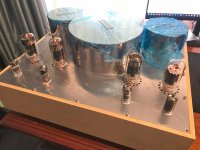Hi. I’m testing my stereo version of Pete Millett’s Engineer’s mono-block amp.
The power supply is different. Being stereo, it needs a much bigger power transformer for a start. It’s also higher voltage/power with regulators running at 525V. The differential input/drivers are 6EJ7s – higher gain than the original 6CB6s.
As in the original design, the 6HJ5 output tube heaters are AC-powered and elevated to 50V.
There’s no global feedback yet – just anode-to-anode feedback. Here’s a link to the original schematic.
Some 1kHz distortion plots look great. Like this one at 1W:

And this one at 2W

Others show 50Hz and 100Hz side-bands around the 1kHz fundamental without much 50Hz:

That's probably the worst one. Where are the 100Hz side-bands coming from?
Or with a lot of 50Hz. This is at 10W

What I’ve found is that this problem is worse with certain output tubes than others, and gets worse as the power level is increased.
My question is, am I seeing artifacts resulting from AC heating of the output tubes or should I be looking for something else?
The power supply is different. Being stereo, it needs a much bigger power transformer for a start. It’s also higher voltage/power with regulators running at 525V. The differential input/drivers are 6EJ7s – higher gain than the original 6CB6s.
As in the original design, the 6HJ5 output tube heaters are AC-powered and elevated to 50V.
There’s no global feedback yet – just anode-to-anode feedback. Here’s a link to the original schematic.
Some 1kHz distortion plots look great. Like this one at 1W:
And this one at 2W
Others show 50Hz and 100Hz side-bands around the 1kHz fundamental without much 50Hz:
That's probably the worst one. Where are the 100Hz side-bands coming from?
Or with a lot of 50Hz. This is at 10W
What I’ve found is that this problem is worse with certain output tubes than others, and gets worse as the power level is increased.
My question is, am I seeing artifacts resulting from AC heating of the output tubes or should I be looking for something else?
Attachments
To hell with the spectrum. When you really have a leakage problem you can get all manner of misbehavior in the circuit, some of which can defy explanation. I’ve had stages latch up, others break into and out of RF oscillations at 60 Hz rates. If you just get a little hum (and the IMD associated with it) its far easier to figure out what happened.
Thanks.
I'll check the ripple on my regulated HT supplies. They're 21st Century Maidas with 25V+ across them so I don't expect them to be the problem. If they're OK, I'll remove the anode to anode feedback and try to see where the 50Hz/100Hz is coming from.
DC is easily arranged for one channel at least for testing.
I'll check the ripple on my regulated HT supplies. They're 21st Century Maidas with 25V+ across them so I don't expect them to be the problem. If they're OK, I'll remove the anode to anode feedback and try to see where the 50Hz/100Hz is coming from.
DC is easily arranged for one channel at least for testing.
On some tube tester there is a check of leakage with cold and warm tube.
And there is a great difference; in the second test is very important because it is a quality test about the tube we are using or a tube it is end of life ( one reason)
The value that must be greater than 10 Mohm
A low value with an ac filaments can generate hum.
Walter
And there is a great difference; in the second test is very important because it is a quality test about the tube we are using or a tube it is end of life ( one reason)
The value that must be greater than 10 Mohm
A low value with an ac filaments can generate hum.
Walter
- Home
- Amplifiers
- Tubes / Valves
- How would heater-cathode leakage in AC-heated power tubes manifest itself?

